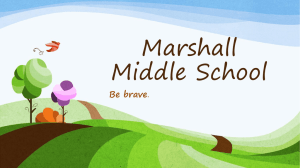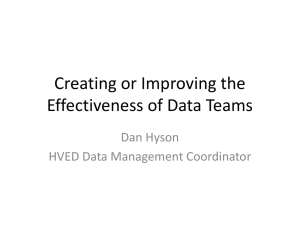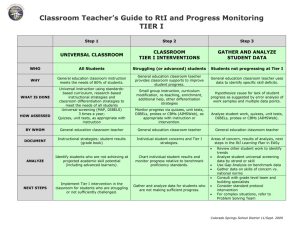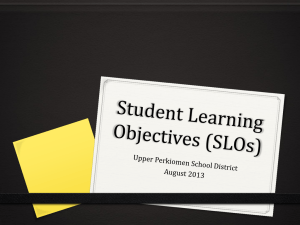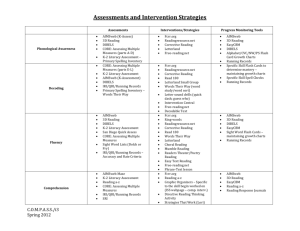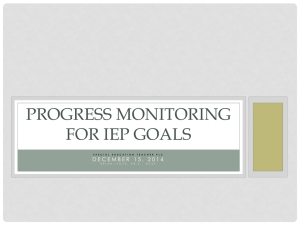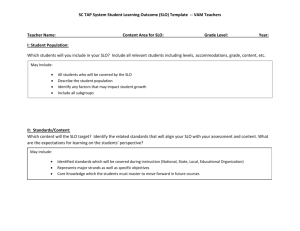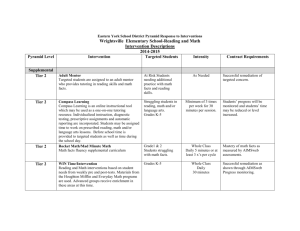SLO Reading 4th SwD GE Co Teaching
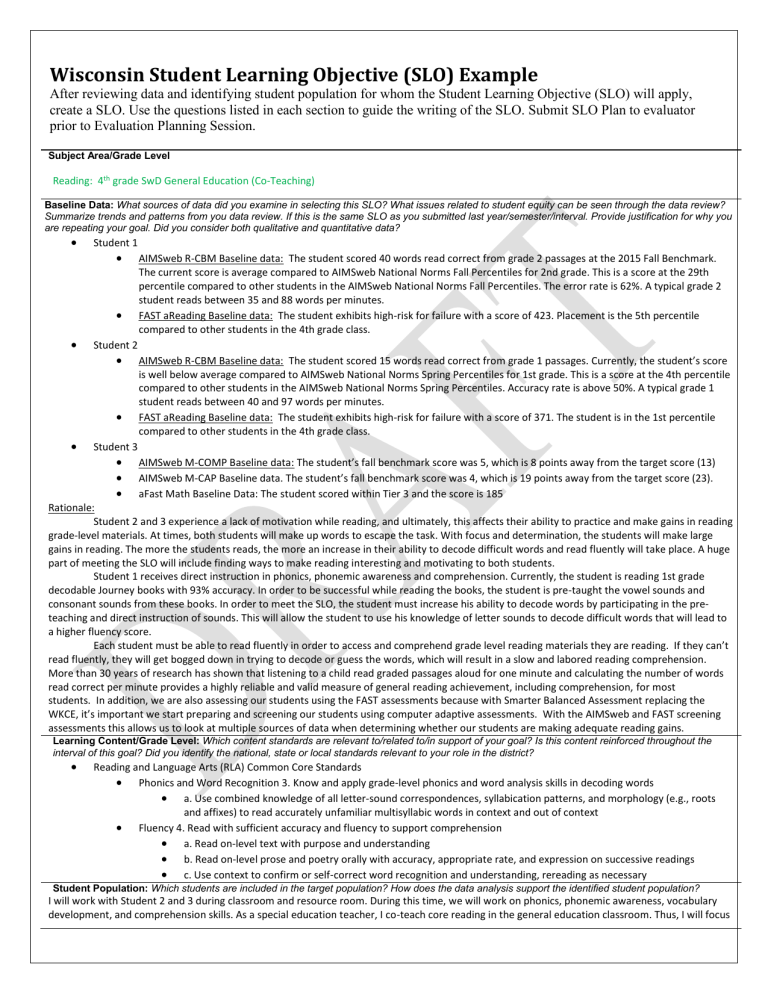
Wisconsin Student Learning Objective (SLO) Example
After reviewing data and identifying student population for whom the Student Learning Objective (SLO) will apply, create a SLO. Use the questions listed in each section to guide the writing of the SLO. Submit SLO Plan to evaluator prior to Evaluation Planning Session.
Subject Area/Grade Level
Reading: 4 th grade SwD General Education (Co-Teaching)
Baseline Data: What sources of data did you examine in selecting this SLO? What issues related to student equity can be seen through the data review?
Summarize trends and patterns from you data review. If this is the same SLO as you submitted last year/semester/interval. Provide justification for why you are repeating your goal. Did you consider both qualitative and quantitative data?
Student 1
AIMSweb R-CBM Baseline data: The student scored 40 words read correct from grade 2 passages at the 2015 Fall Benchmark.
The current score is average compared to AIMSweb National Norms Fall Percentiles for 2nd grade. This is a score at the 29th percentile compared to other students in the AIMSweb National Norms Fall Percentiles. The error rate is 62%. A typical grade 2 student reads between 35 and 88 words per minutes.
FAST aReading Baseline data: The student exhibits high-risk for failure with a score of 423. Placement is the 5th percentile compared to other students in the 4th grade class.
Student 2
AIMSweb R-CBM Baseline data: The student scored 15 words read correct from grade 1 passages. Currently, the student’s score is well below average compared to AIMSweb National Norms Spring Percentiles for 1st grade. This is a score at the 4th percentile compared to other students in the AIMSweb National Norms Spring Percentiles. Accuracy rate is above 50%. A typical grade 1 student reads between 40 and 97 words per minutes.
FAST aReading Baseline data: The student exhibits high-risk for failure with a score of 371. The student is in the 1st percentile compared to other students in the 4th grade class.
Student 3
AIMSweb M-COMP Baseline data: The student’s fall benchmark score was 5, which is 8 points away from the target score (13)
AIMSweb M-CAP Baseline data. The student’s fall benchmark score was 4, which is 19 points away from the target score (23).
aFast Math Baseline Data: The student scored within Tier 3 and the score is 185
Rationale:
Student 2 and 3 experience a lack of motivation while reading, and ultimately, this affects their ability to practice and make gains in reading grade-level materials. At times, both students will make up words to escape the task. With focus and determination, the students will make large gains in reading. The more the students reads, the more an increase in their ability to decode difficult words and read fluently will take place. A huge part of meeting the SLO will include finding ways to make reading interesting and motivating to both students.
Student 1 receives direct instruction in phonics, phonemic awareness and comprehension. Currently, the student is reading 1st grade decodable Journey books with 93% accuracy. In order to be successful while reading the books, the student is pre-taught the vowel sounds and consonant sounds from these books. In order to meet the SLO, the student must increase his ability to decode words by participating in the preteaching and direct instruction of sounds. This will allow the student to use his knowledge of letter sounds to decode difficult words that will lead to a higher fluency score.
Each student must be able to read fluently in order to access and comprehend grade level reading materials they are reading. If they can’t read fluently, they will get bogged down in trying to decode or guess the words, which will result in a slow and labored reading comprehension.
More than 30 years of research has shown that listening to a child read graded passages aloud for one minute and calculating the number of words read correct per minute provides a highly reliable and valid measure of general reading achievement, including comprehension, for most students. In addition, we are also assessing our students using the FAST assessments because with Smarter Balanced Assessment replacing the
WKCE, it’s important we start preparing and screening our students using computer adaptive assessments. With the AIMSweb and FAST screening assessments this allows us to look at multiple sources of data when determining whether our students are making adequate reading gains.
Learning Content/Grade Level: Which content standards are relevant to/related to/in support of your goal? Is this content reinforced throughout the interval of this goal? Did you identify the national, state or local standards relevant to your role in the district?
Reading and Language Arts (RLA) Common Core Standards
Phonics and Word Recognition 3. Know and apply grade-level phonics and word analysis skills in decoding words
a. Use combined knowledge of all letter-sound correspondences, syllabication patterns, and morphology (e.g., roots and affixes) to read accurately unfamiliar multisyllabic words in context and out of context
Fluency 4. Read with sufficient accuracy and fluency to support comprehension
a. Read on-level text with purpose and understanding
b. Read on-level prose and poetry orally with accuracy, appropriate rate, and expression on successive readings
c. Use context to confirm or self-correct word recognition and understanding, rereading as necessary
Student Population: Which students are included in the target population? How does the data analysis support the identified student population?
I will work with Student 2 and 3 during classroom and resource room. During this time, we will work on phonics, phonemic awareness, vocabulary development, and comprehension skills. As a special education teacher, I co-teach core reading in the general education classroom. Thus, I will focus
on helping Student 1 comprehend the reading material by providing instruction on comprehension strategies, such as graphic organizers, visuals, sentence starters, etc. Typically, instruction takes place in a small group of students, including student 1. The general education teacher and I split the instruction into stations.
As a co-teacher, the general education teacher and I split the class into two groups. I usually work with a smaller group who needs skills re-taught.
Student 3 will be a part of this group. The setting will be distraction-free, and the smaller group will allow me to work with the student more one-onone.
Targeted Growth: Have you identified the starting point for each target student? How did you arrive at these growth goals?
Students 1 and 3 will move up one tier. Student 2 will remain at tier 3
Time Interval: Does the goal apply to the duration of the time you spend with your student population e.g., by year, semester or tri-semester)?
This objective will take place over the course of the school year.
Evidence Sources: What benchmark assessments will you use (pre-instruction, mid-interval or post-instruction? What formative practices will you use to monitor progress throughout the interval? What summative assessment will you use to determine student growth at the end of the interval? Is the assessment aligned to the instructional content within the SLO, is it free of bias and is it appropriate for the identified student population?
Students will be measured by the following:
Weekly AIMSweb probes
Winter and Spring AIMSweb benchmark assessments
Winter and Spring Fast benchmark assessments
SLO Goal Statement (SMART Criteria): Goals should be SMART = Specific, Measureable, Attainable, Results-based, and Time-bound.
Student 1
By May 2016, when given a 2nd grade R-CBM probe, the student will read 106 words correctly per minute with 95% accuracy, which correlates to the 50th percentile according to AIMSweb National Norms Spring Percentile.
By May 2016, the student will score within Tier 2 Spring Target according to FAST aReading.
Student 2
By May 2016, when given a 1st grade R-CBM probe, the student will read 51 words correctly per minute with 95% accuracy, which correlates to the 35th percentile goal according to AIMSweb National Norms Spring Percentiles.
Student 3
By May 2016, the student will score within Tier 2 Spring Target according to R-CBM AIMSweb National Norms.
By May 2016, the student will score within Tier 2 Spring Target according to R-CBM AIMSweb National Norms.
Instructional Strategies and Supports: What professional development opportunities support this goal? What instructional methods will you employ so that student ’s progress toward the identified growth goal? How will you differentiate instruction to support multiple goals within your population? Who might you collaborate within order to support the unique learning needs within your group?
1.
TIER 1 interventions using small group differentiated reading instruction focused on decoding and fluency for at a minimum of 45 minutes based off of the District’s Universal Reading Guidelines/Template during the 90 minute reading block.
2.
The students will use graphic organizers while reading the story from the Journey’s curriculum.
3.
Pre-teach the vowel sounds and consonant sounds from the Journey books.
4.
With two teachers in the room, the students will be placed in a smaller, more individualized group.
5.
Formative assessments will implemented at least three times/week during core reading instruction to determine if students are mastering power standards. I will keep a record of the data on which students achieved 80% or higher on formative assessments and how the data informed by instruction.
6.
For student 2 I will implement the direct instruction reading program and utilize leveled books that contain sight words for 20 minutes/5 days per week. I will assess the students' growth and performance weekly using the AIMSweb probes. .
7.
Meet with Co-Teaching partner to discuss the Journey’s curriculum and specific strategies to make specific adaptations for the three students to gain access to the curriculum.
